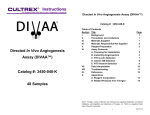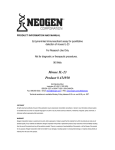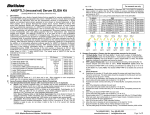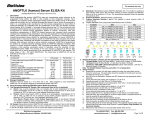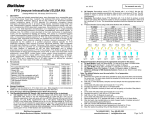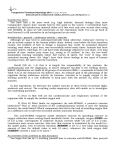Download ACE2 (human) ELISA Kit
Transcript
BioVision ACE2 (human) ELISA Kit d) (Catalog #K4918-100; 100 assays; Store kit at 4°C) I. II. Description: By EST database searching for sequences showing homology to the zinc metalloprotease angiotensin-I converting enzyme, a full-length ACE2 cDNA, originally called ACEH, was isolated, which encoded a deduced 805-amino acid protein that shares approximately 40% identity with the N- and C-terminal domains of ACE. ACE2 contains a potential 17-amino acid N-terminal signal peptide and a putative 22-amino acid C-terminal membrane anchor. Northern blot analysis detected high expression of ACE2 in kidney, testis, and heart, and moderate expression in colon, small intestine, and ovary. The soluble, truncated form of ACE2 lacks the transmembrane and cytosolic domains in CHO cells and is glycosylated protein that was able to cleave angiotensin I and angiotensin II , but not bradykinin. ACE converts angiotensin I to angiotensin II, which has 8 amino acids, ACE2 converts angiotensin I to angiotensin 1-9, which has 9 amino acids. This can then further be converted by ACE to a shorter peptide, angiotensin 1-7, which is a blood vessel dilator. Using ACE2 null mice, Crackower et al. showed that ACE2 was critically involved in a cardiac contractility. This assay is a sandwich Enzyme LinkedImmunosorbent Assay (ELISA) for quantitative determination of human ACE2 in biological fluids. A polyclonal antibody specific for ACE2 has been precoated onto the 96-well microtiter plate. Standards and samples are pipetted into the wells for binding to the coated antibody. After extensive washing to remove unbound compounds, ACE2 is recognized by the addition of a biotinylated polyclonal antibody specific for ACE2 (Detection Antibody). After removal of excess biotinylated antibody, HRP labeled streptavidin (Detector) is added. Following a final washing, peroxidase activity is quantified using the substrate 3,3’,5,5’-tetramethylbenzidine (TMB). The intensity of the color reaction is measured at 450 nm after acidification and is directly proportional to the concentration of ACE2 in the samples. The assay range is 0.391–25 ng/ml ACE2/ml. The lowest level of ACE2 that can be detected by this assay is 293 pg/ml. Kit Contents: Component 1 plate coated with human ACE2 Antibody 1 bottle Wash Buffer 10X 1 bottle Diluent 5X 1 bottle Detection Antibody 1 vial Detector 100X (HRP Labeled Streptavidin) 1 vial human ACE2 Standard (lyophilized) 1 vial human ACE2 QC sample (lyophilized) 1 bottle TMB Substrate Solution 1 bottle Stop Solution 3 plate sealers (plastic film) 100 Assays (12 x 8-well strips) (50 ml) (50 ml) (12 ml) (150 µl) (50 ng) 1 vial (12 ml) (12 ml) (12 x 8-well strips) Part Number K4918-100-1 K4918-100-2 K4918-100-3 K4918-100-4 K4918-100-5 K4918-100-6 K4918-100-7 K4918-100-8 K4918-100-9 K4918-100-10 III. Storage Conditions: Reagents must be stored at 2 - 8°C when not in use. Bring reagents to room temperature before use. Do not expose reagents to temperatures greater than 25°C. IV. Assay Procedure (Read the ENTIRE Protocol Before Proceeding) Test Samples/Standards/QC Sample: (We recommend these be run in duplicate) a. Urine: Aseptically collect the urine of the day, voided directly into a sterile container. Assay immediately or aliquot and store at ≤ -20oC. Avoid repeated freeze/thaw cycles. b. c. For research use only rev. 02/12 Cell Culture Supernatant has to be diluted in Diluent 1X. Samples containing visible precipitates must be clarified before use. NOTE: As a starting point, 1/2 dilution of urine is recommended! If samples fall the outside range of assay, a lower or higher dilution may be required! QC Sample: Reconstitute Human ACE2 QC sample with 1 ml of dH2O. Mix the QC Sample to ensure complete reconstitution. Allow to sit for a minimum of 15 min. The QC Sample is ready to use-do not dilute it (refer to the C of A for current QC Sample concentration). BioVision Incorporated 155 S. Milpitas Boulevard, Milpitas, CA 95035 USA e) f) Standards: Reconstitute human ACE2 Standard with 1 ml of dH2O to produce a stock solution (50 ng/ml). Mix the Stock solution to ensure complete reconstitution. Allow to sit for a minimum of 15 min. The reconstituted standard should be aliquoted and stored at -20°C. Prepare 1X Diluent: Dilute 5X Diluent 1:4 with dH2O. Prepare Standard Curve using 2-fold serial dilutions with 1X Diluent: To obtain 25 ng/ml 12.5 ng/ml 6.25 ng/ml 3.125 ng/ml 1.563 ng/ml 0.781 ng/ml 0.391 ng/ml 0 ng/ml 300 µl 50 ng/ml Add 300 µl of ACE2 (50 ng/ml) 300 µl of ACE2 (25 ng/ml) 300 µl of ACE2 (12.5 ng/ml) 300 µl of ACE2 (6.25 ng/ml) 300 µl of ACE2 (3.125 ng/ml) 300 µl of ACE2 (1.563 ng/ml) 300 µl of ACE2 (0.781 ng/ml) 300 µl of Diluent 1X 300 µl 25 ng/ml 12.5 ng/ml 300 µl 6.25 ng/ml 300 µl 3.125 ng/ml 300 µl Into 300 μl of 1X Diluent 300 μl of 1X Diluent 300 μl of 1X Diluent 300 μl of 1X Diluent 300 μl of 1X Diluent 300 μl of 1X Diluent 300 μl of 1X Diluent Empty tube 300 µl 1.563 ng/ml 300 µl 0.781 0.391 0 ng/ml ng/ml ng/ml 2. Reagent Preparation: (Prepare just the appropriate amounts for the assay) a) 1X Wash Buffer: Dilute 10X Wash Buffer 1: 9 with dH2O to obtain 1X Wash Buffer. b) 1X Diluent: Dilute 5X Wash Buffer 1: 4 with dH2O to obtain 1X Diluent. c) 1X Detector 100X (HRP Labeled Streptavidin): Dilute 100X Detector 1: 99 with 1X Diluent to obtain 1X Detector. Note: The diluted Detector must be used within 1 hr of preparation 3. Assay Protocol: a) Determine the number of 8-well strips needed for assay and insert them into the frame for current use. The extra strips should be resealed in the foil pouch and can be stored at 4°C for up to 1 month. b) Add 100 μl of the Standards, Samples and QC Sample into the appropriate wells in duplicate. c) Cover plate with plate sealer and incubate for 1 hr at 37°C. d) Aspirate and wash x 3 with 300 μl of 1X Wash Buffer. e) Warm Detection Antibody to room temperature. Add 100 μl to each well and tap gently on the side of the plate to mix. f) Cover plate with plate sealer and incubate for 1 hr at 37°C. g) Aspirate and wash x 3 with 300 μl of 1X Wash Buffer. h) Add 100 μl of the 1X Detector to each well. i) Cover plate with plate sealer and incubate for 1 hr at 37°C. j) Remove plate from 37°C, aspirate and wash x 5 with 300 μl of 1X Wash Buffer. k) After last wash, tap inverted plate on a stack of paper towels. Complete removal of liquid is essential for good performance. l) Add 100 µl of TMB Substrate Solution. m) Allow the color to develop at room temperature in the dark for 30 min. n) Stop the reaction by adding 100 μl of Stop Solution to each well. o) Tap the plate gently to ensure thorough mixing. The substrate reaction yields a blue solution that turns yellow when Stop Solution is added. Caution: Stop Solution is a Corrosive Solution p) Measure the OD at 450 nm in an ELISA plate reader within 30 min. Tel: 408-493-1800 | Fax: 408-493-1801 www.biovision.com | [email protected] Page 1 of 2 BioVision V. 1. 2. 3. 4. For research use only rev. 02/12 Calculations: Average the duplicate readings for each standard, QC and sample and subtract the average blank value (obtained with the 0 ng/ml point). Generate the standard curve by plotting the average absorbance obtained for each standard concentration on the horizontal (X) axis vs. the corresponding ACE2 concentration (ng/ml) on the vertical (Y) axis (see 10. TYPICAL DATA). Calculate the ACE2 concentrations of samples by interpolation of the regression curve formula as shown above in a form of a quadratic equation. If the test samples were diluted, multiply the interpolated values by the dilution factor to calculate the concentration of human ACE2 in the samples. 3. Recovery: When samples (urine) are spiked with known concentrations of human ACE2, the recovery averages 95% (range from 81% to 113%). Samples 1 2 3 4 5 4. Average Recovery (%) 90.8 93.4 95.1 95.4 100.7 Range (%) 81-97 84-109 84-111 89-105 90-113 Expected values: ACE2 levels range in urine from 1 to > 10 ng/ml (from healthy donors). Technical Hints and Limitations: It is recommended that all standards, QC sample and samples be run in duplicate. Do not combine leftover reagents with those reserved for additional wells. Reagents from the kit with a volume less than 100 µl should be centrifuged. Residual wash liquid should be drained from the wells after last wash by tapping the plate on absorbent paper. Crystals could appear in the 10X solution due to high salt concentration in the stock solutions. Crystals are readily dissolved at room temperature or at 37°C before dilution of the buffer solutions. Once reagents have been added to the 8-well strips, DO NOT let the strips DRY at any time during the assay. Keep TMB Substrate Solution protected from light. The Stop Solution consists of phosphoric acid. Although diluted, the Stop Solution should be handled with gloves, eye protection and protective clothing. VI. Performance Characteristics: 1. Intra-assay precision: Six samples of known concentrations of human ACE2 were assayed in replicates 11 times to test precision within an assay. Samples 1 2 3 4 5 6 Mean 2.785 4.120 12.680 15.034 24.705 45.697 Troubleshooting: SD 0.169 0.254 1.257 0.807 1.319 3.724 CV (%) 6.079 6.164 9.914 5.365 5.338 8.149 n 11 11 11 11 11 11 PROBLEM Mean 4.105 8.726 11.280 16.913 22.861 49.219 SD 0.445 0.617 1.121 1.045 1.236 3.144 CV (%) 10.829 7.069 9.937 6.179 5.401 6.388 FOR RESEARCH USE ONLY! Not to be used on humans. BioVision Incorporated 155 S. Milpitas Boulevard, Milpitas, CA 95035 USA n 11 11 11 11 11 11 SOLUTIONS Omission of key reagent Check that all reagents have been added in the correct order. Washes too stringent Use an automated plate washer if possible. Incubation times No signal or weak inadequate signal Plate reader settings not optimal Incorrect assay temperature 2. Inter-assay precision: Six samples of known concentrations of human ACE2 were assayed in 11 separate assays to test precision between assays. Samples 1 2 3 4 5 6 POSSIBLE CAUSES High background Poor standard curve Unexpected results Incubation times should be followed as indicated in the manual. Verify the wavelength and filter setting in the plate reader. Use recommended incubation temperature. Bring substrates to room temperature before use. Concentration of detector too high Use recommended dilution factor. Inadequate washing Ensure all wells are filling wash buffer and are aspirated completely. Wells not completely aspirated Completely aspirate wells between steps. Reagents poorly mixed Be sure that reagents are thoroughly mixed. Omission of reagents Dilution error Be sure that reagents were prepared correctly and added in the correct order. Check pipetting technique and double-check calculations. Tel: 408-493-1800 | Fax: 408-493-1801 www.biovision.com | [email protected] Page 2 of 2


